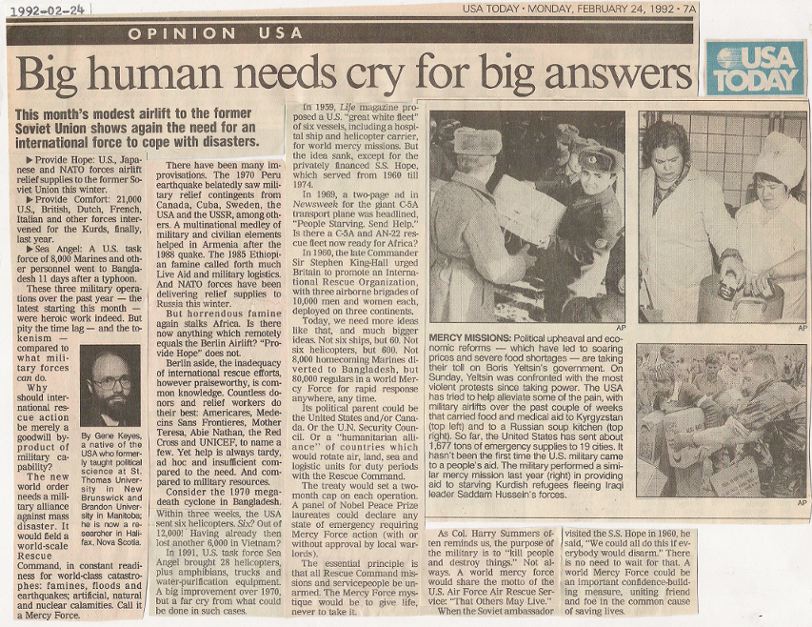
|
Re-format note, 2014-10-05: "Mercy Force" was the original name of this article by Gene Keyes, published in the USA Today
Opinion page 1992-02-24, with a new title by the editor. It is reprinted
here in HTML for legibility and search purposes, and below that is a jpeg
of how the article looked on newsprint. (In 2006 I had these two items on separate Web pages.)
|
Big human needs cry for big answersThis month’s modest airlift to the former Soviet Union shows again the need for an international force to cope with disasters. By Gene Keyes, a native of the USA who formerly taught political science at St. Thomas University in New Brunswick and Brandon University in Manitoba, he is now a researcher in [Berwick], Nova Scotia.
These three military operations over the past year—the latest starting
this month—were heroic work indeed. But pity the time lag—and the tokenism—compared
to what military forces can do.
Why should international rescue action be merely a goodwill by-product of military capability? The new world order needs a military alliance against mass disaster. It would field a world-scale Rescue Command, in constant readiness for world-class catastrophes: famines, floods, and earthquakes; artificial, natural, and nuclear calamities. Call it a Mercy Force. There have been many improvisations. The 1970 Peru earthquake belatedly saw military relief contingents from Canada, Cuba, Sweden, the USA and the USSR, among others. A multinational medley of military and civilian elements helped in Armenia after the 1988 quake. The 1985 Ethiopia famine called forth much Live Aid and military logistics. And NATO forces have been delivering relief supplies to Russia this winter. But horrendous famine again stalks Africa. Is there now anything which remotely equals the Berlin Airlift? "Provide Hope" does not. Berlin aside, the inadequacy of international rescue efforts, however, praiseworthy, is common knowledge. Countless donors and relief workers do their best: Americares, Medecins Sans Frontieres, Mother Teresa, Abie Nathan, the Red Cross and UNICEF, to name a few. Yet help is always tardy, ad hoc and insufficient compared to the need. And compared to military resources. Consider the 1970 megadeath cyclone in Bangladesh. Within three weeks, the USA sent six helicopters. Six? Out of 12,000! Having already lost another 6,000 in Vietnam? In 1991, the U.S. task force Sea Angel brought 28 helicopters, plus amphibians, trucks and water-purification equipment. A big improvement over 1970, but a far cry from what could be done in such cases. In 1959, Life magazine proposed a U.S. "great white fleet" of six vessels, including a hospital ship and helicopter carrier for world mercy missions, but the idea sank, except for the privately financed S.S. Hope, which served from 1960 till 1974. In 1969, a two-page ad in Newsweek for the giant C-5A transport plane was headlined, "People Starving. Send Help." Is there a C-5A and AN-22 rescue fleet now ready for Africa? In 1960, the late Commander Sir Stephen King-Hall urged Britain to promote an International Rescue Organization, with three airborne brigades of 10,000 men and women each, deployed on three continents. Today, we need more ideas like that, and much bigger ideas. Not six ships, but 60. Not six helicopters, but 600. Not 8,000 homecoming Marines diverted to Bangladesh, but 80,000 regulars in a world Mercy Force for rapid response anywhere, any time. Its political parent could be the United States and/or Canada. Or the U.N. Security Council. Or a "humanitarian alliance" of countries which would rotate air, land, sea, and logistic units for duty periods with the Rescue Command. The treaty would set a two month cap on each operation. A panel of Nobel Peace Price laureates could declare any state of emergency requiring Mercy Force action (with or without approval by local warlords). The essential principle is that all rescue Command missions and servicepeople be unarmed. The Mercy Force mystique would be to give life, never to take it. As Col. Harry Summers often reminds us, the purpose of the military is to "kill people and destroy things." Not always. A world mercy force would share the motto of the U.S. Air Force Air Rescue Service "That Others May Live". When the Soviet ambassador visited the S.S. Hope in 1960, he said. "We
could all do this if everybody would disarm." There is no need to wait for
that. A world Mercy Force could be an important confidence-building measure,
uniting friend and foe in the common cause of saving lives. [Captions for photos omitted from this HTML reprint:] |

|
|
Related works by Gene Keyes
"World-Wide Rescue" (Policy Options, 1984-07) p. 27-28 To Give Life: A Nonkilling Military Precedents and Possibilities 70-page illustrated monograph exploring these ideas in wider scope. (2014) |